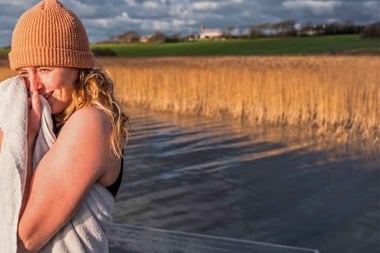
How wonderful is walking? This long-overlooked activity isn’t just a form of exercise: it’s part of what makes us human. The truth is, walking can be whatever we want it to be: fun and exciting, relaxing and soul-nourishing, social, or even a great workout. As a bonus, it’s free and requires minimal equipment and preparation. Walking’s beauty lies in its simplicity. This spring, let’s rediscover how wondrous walking can be.
The benefits of walking
The advantages of walking are mental and physical. Walking …
- can help you meet your physical activity goals and improve your cardiovascular fitness, allowing you to get your heart pumping, body moving, and muscles working hard
- is associated with a reduced risk of major depression
- has been shown in research to help reduce mortality, as well as the risks for common diseases such as cancer, heart disease, and diabetes
- may help improve our sleep quality, according to recent scientific studies
- is thought to give our creativity a boost, promoting creative thinking
- has been shown to improve our focus, productivity, cognition, and attention
- is an eco-friendly way to get around, compared to driving
Not all walking is created equal
Research tells us that walking outdoors in nature is especially healthy and enjoyable. For example, in a 2014 study that explored the link between walking and creative thinking, walking outside produced the most creative ideas, according to the researchers.
Similarly, a new study from 2022 showed that a one-hour walk in nature decreased stress-related brain activity in participants. Happily, this means that we can reap the rewards even after a single enjoyable walk.
10 wondrous walks to try
Who says that walking has to be boring? Sure, you can lace up your runners and head around the block. But for a change of pace, consider one of these creative walk ideas.
Soundwalks
Sometimes we focus on scenery but pay less attention to our other senses. Take a walk with natural sounds in mind. Plan a walk that features sounds such as waves or birds, and immerse yourself in your beautiful-sounding surroundings.
Labyrinth walks
Commonly mistaken for mazes, labyrinths don’t have dead ends. Instead, there is only one path to walk, which leads to the centre and then back again. Many people find the ancient practice of labyrinth walking calming and meditative. Look online to find a labyrinth near you.
Nordic walking
Walking with poles originated as a summer training regimen for cross-country skiers. Now people all over the world employ Nordic walking poles to help them use more muscles and burn more calories than with regular walking. As an added bonus, the poles help stabilize walkers.
Litter cleanup walks
Make an already eco-friendly practice even more eco-friendly, and earn some good karma in the process by picking up litter on your neighbourhood walks. (Safety first! Use protective equipment and don’t pick up anything dangerous.) Some people even combine jogging with picking up litter and call it “plogging.”
Guided nature walks
A wonderful way to learn more about the plants and animal species near you is a guided nature walk. Look for programs offered by your local community centre, nature centre, or botanical garden. You may even be able to get involved in restoration initiatives and invasive species removal.
Walks for charity
Don’t feel like running a 5 K for charity? No problem! Many charity walks exist across the country. Grab some friends or create a workplace team and fundraise while walking for a great cause—and having fun.
Historical, architectural, or cultural walks
Many of us enjoy guided historical, architectural, or cultural walks on vacations, such as when we’re exploring a new city. But what about at home? There’s a good chance you’ll learn something new and have a fantastic time (and rack up some serious steps) on a walking tour in your city. Or you could learn some spooky local history with a ghost tour!
Forest bathing walks
The Japanese practice of shinrin-yoku (translated into English as “forest bathing”) means fully immersing oneself in the forest to reap the healing benefits of nature. It’s about being present and mindful, taking in the atmosphere of the forest, and it can be deeply restorative.
Foraging walks
Take a guided walk with a trained forager who can teach you how to identify edible plants or mushrooms. Some walks are identification only, rather than harvesting. (Always ensure that you follow safety and environmental protocols when foraging.)
Geocaching walks
Geocaching is a hobby that involves using GPS coordinates to find hidden items called “geocaches.” Think of it as a treasure hunt, but with more technology. Geocaches are often hidden in parks, making for fun and exciting walks.
Walking safety tips
- Dress for the weather, such as with waterproof boots or a sun hat.
- Stay visible by wearing reflective gear and bright- or light-coloured clothing.
- Make sure someone knows where you are and when you’ll be home.
- Educate yourself on what sorts of wild animals you may run into (urban areas can have wild animals too, such as coyotes) and what you’ll do if you see one.
- Keep the volume down on your earbuds so you can hear motorists and cyclists.
- Carry identification with you in case of emergencies.
- Create and follow a safety plan, and always be aware of your surroundings.
Fun walks to do with your kids
| Colour walks | Challenge your kids to find as many things as possible in their favourite colour or find an item of every colour of the rainbow. |
| Scavenger hunts | Create a scavenger hunt that encourages little ones to become aware of the nature all around them. |
| “I spy” walks | Play “I spy” on your walk, and consider bringing a magnifying glass or binoculars. |
Walking versus aging
According to a 2022 study that included more than 400,000 adults, brisk walking may help slow the aging process. The researchers found a link between walking pace and telomere length (a marker for biological aging).
Get good shoes!
Consider getting a professional shoe fitting, such as a specialty running store. The pros there may be able to recommend orthotics to make your feet feel amazing!
Walk and talk
Bring the benefits of walking to your workplace with walking meetings! Suggest the idea to your supervisor as a fun way to boost creative problem-solving, collaboration, and healthy fun as a team.
10,000 is just a number
Aiming for 10,000 steps a day? That now-famous number has been traced back to a Japanese marketing campaign from 1965. While 10,000 may not be the magical number we once thought it was, it’s not a bad step count to aim for. However, don’t be discouraged if you don’t hit that target. Studies have demonstrated health benefits at lower step counts, too.





